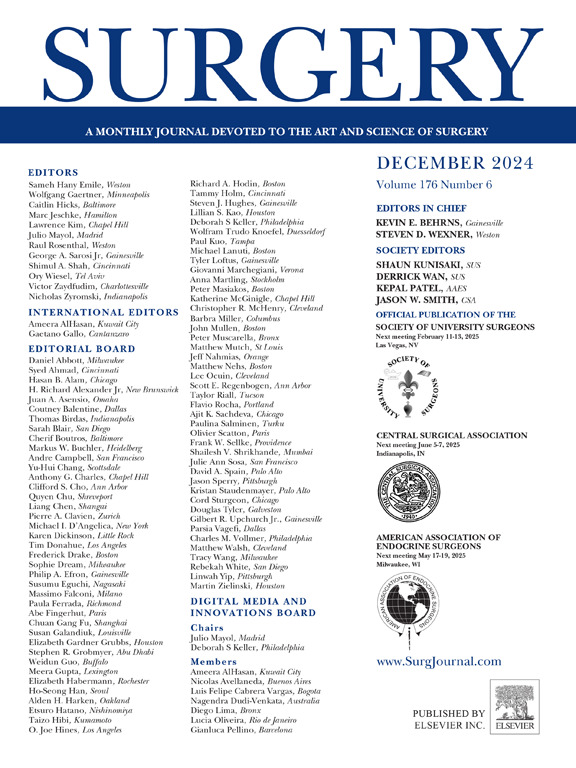Clinical efficacy of pancreas-preserving distal pancreatectomy for the treatment of pancreatic ductal adenocarcinoma
IF 3.2
2区 医学
Q1 SURGERY
引用次数: 0
Abstract
Background
The long-term survival rate of patients with pancreatic ductal adenocarcinoma has improved alongside the development of multidisciplinary treatment, and there is now demand for less invasive surgery that maintains postoperative pancreatic function. We evaluated the efficacy of pancreas-preserving distal pancreatectomy in terms of oncologic parameters and postoperative pancreatic function.
Methods
The data of 98 consecutive patients who underwent distal pancreatectomy for the treatment of pancreatic ductal adenocarcinoma between 2012 and 2022 in our institution were retrospectively analyzed. The surgical outcomes, overall survival, and postoperative pancreatic function were compared between pancreas-preserving distal pancreatectomy, in which the pancreatic stump was distal to the left margin of the portal vein on postoperative computed tomography, and conventional distal pancreatectomy.
Results
Sixteen patients (16%) underwent pancreas-preserving distal pancreatectomy. Fewer lymph nodes were dissected in the pancreas-preserving distal pancreatectomy group than the conventional distal pancreatectomy group (19 vs 31, respectively; P < .01); however, the R0 resection rate (94% vs 93%, respectively; P = 1.00), recurrence-free survival, and overall survival were similar. Similar results were obtained in an analysis limited to patients with pancreatic ductal adenocarcinoma in the pancreatic tail. Patients who underwent pancreas-preserving distal pancreatectomy were less likely to develop worsening of their diabetes than those who underwent conventional distal pancreatectomy (19% vs 39%, respectively; P = .16). Nonalcoholic fatty liver disease newly developed in 22% of the patients who underwent conventional distal pancreatectomy but in none of those who underwent pancreas-preserving distal pancreatectomy (P = .04).
Conclusion
The pancreatic transection site should be distally located to preserve postoperative pancreatic function when R0 resection can be achieved.

保胰远端胰腺切除术治疗胰管腺癌的临床疗效观察。
背景:胰腺导管腺癌患者的长期生存率随着多学科治疗的发展而提高,现在需要微创手术来维持术后胰腺功能。我们从肿瘤参数和术后胰腺功能方面评估了保留胰腺的远端胰腺切除术的疗效。方法:回顾性分析我院2012 ~ 2022年连续行胰腺远端切除术治疗胰管腺癌的98例患者资料。比较保留胰腺的远端胰腺切除术(术后计算机断层扫描显示胰腺残端位于门静脉左缘远端)和传统远端胰腺切除术的手术结果、总生存率和术后胰腺功能。结果:16例(16%)患者行远端胰腺切除术。保留胰腺的远端胰腺切除术组比传统远端胰腺切除术组清扫的淋巴结少(分别为19 vs 31;P < 0.01);然而,R0切除率分别为94%和93%;P = 1.00),无复发生存期和总生存期相似。在一项仅限于胰腺尾部胰腺导管腺癌患者的分析中也获得了类似的结果。行保留胰腺远端胰腺切除术的患者比行常规远端胰腺切除术的患者糖尿病恶化的可能性更小(分别为19% vs 39%;P = .16)。22%接受常规远端胰腺切除术的患者新发非酒精性脂肪性肝病,而没有接受保留胰腺远端胰腺切除术的患者新发非酒精性脂肪性肝病(P = 0.04)。结论:在R0切除可行的情况下,胰腺横断部位应选择远端,以保留术后胰腺功能。
本文章由计算机程序翻译,如有差异,请以英文原文为准。
求助全文
约1分钟内获得全文
求助全文
来源期刊

Surgery
医学-外科
CiteScore
5.40
自引率
5.30%
发文量
687
审稿时长
64 days
期刊介绍:
For 66 years, Surgery has published practical, authoritative information about procedures, clinical advances, and major trends shaping general surgery. Each issue features original scientific contributions and clinical reports. Peer-reviewed articles cover topics in oncology, trauma, gastrointestinal, vascular, and transplantation surgery. The journal also publishes papers from the meetings of its sponsoring societies, the Society of University Surgeons, the Central Surgical Association, and the American Association of Endocrine Surgeons.
 求助内容:
求助内容: 应助结果提醒方式:
应助结果提醒方式:


